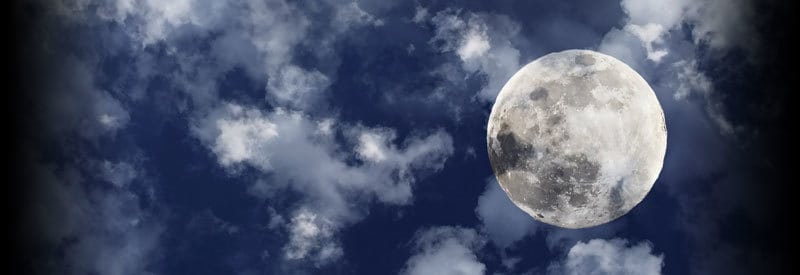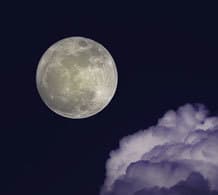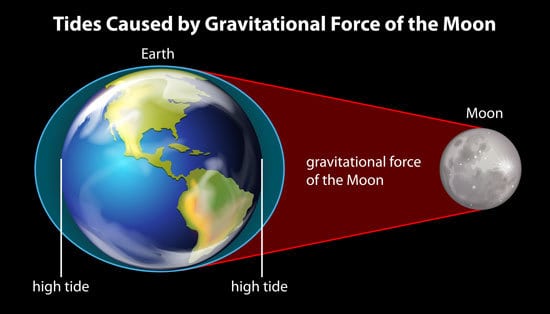How The Moon Affects Our Weather And Climate

It may be hard to imagine that the Moon, approximately 380 000 km or 236 000 miles away, can have any influence on the weather on our planet. However, it plays a more significant role than one might think.
The Moon has a significant impact on our weather, but indirectly. Through its gravitational force, the Moon affects the ocean's tidal activity, which impacts the flow of the ocean currents. The flow of cold and warm ocean currents, in turn, determines weather conditions in many parts of the world.
One can easily assume that a "piece of rock" this far away from Earth and a quarter of its size will have very little if any influence on the planet's atmospheric conditions. But you know what they say about assumptions...
In short, the moon does impact the planet's weather, but not in the way you may think.
This article explains how and why the moon impacts the weather and examines the mechanisms involved in the process.
Does The Moon Affect The Weather?
Clearly, a much broader explanation is needed to fully understand exactly how the moon impacts the planet's atmospheric conditions. But first, we need a more concise and precise answer to the primary question this post is addressing.
How The Moon Affects The Weather

The Moon has a significant impact on our weather, but indirectly. Through its gravitational force, the Moon affects the ocean's tidal activity, which impacts the flow of the ocean currents. The flow of cold and warm ocean currents, in turn, determines weather conditions in many parts of the world.
From this cryptic description, it is evident that the moon's gravity, its tidal activity, and the ocean currents are the key components involved in the manipulation of weather activity in the atmosphere. The upcoming section will lay out exactly how this process takes place.
The primary way in which the moon affects the weather is through the indirect manipulation of ocean currents. The type of weather introduced to a new region, as a result, will largely depend on the properties of the ocean water present in the affected current.
(Warm water will favor cloud formation and is almost synonymous with tropical Cyclone development. Cold water, on the other hand, is more conducive to the creation of dry weather conditions.)
A second notable effect of the moon on atmospheric conditions is its impact on polar temperatures. Measurements taken by satellite showed that temperatures at the Poles are higher during Full Moon than New Moon.
On average, temperatures during Full Moon are 0.55° Celsius (0.99° Fahrenheit) higher than New Moon. These temperatures may seem small and insignificant, but even at this scale, it still has a significant effect on weather.
A less significant effect of the moon is its ability to increase air pressure at the edge of a tidal bulge, as the increased water height causes the air to compress slightly. In this case, the increase in atmospheric pressure is not large enough to have any impact on the weather.
How The Moon Affects The Weather
This section describes how the moon affects the weather on our planet. To understand the steps involved in this process, one needs to clarify two of the key components:
- Gravity
- Ocean Tides
As already stated, gravity is one of the primary factors allowing the moon to influence weather and climate. In fact, it is ONLY the moon's gravitational force that enables it to have any impact on the Earth's atmospheric conditions.
As a result, it is essential to understand how gravity works and how it allows the moon and other celestial bodies with mass to exert force on different objects.
1) Gravitational Force Of The Moon On Earth
Gravity is the strength with which the planets and other large celestial bodies attract objects to their centers. All objects with mass have gravity. And it is the large mass of the moon that enables it to display the strong gravitational force that even influences objects on Earth.

Diagram showing the impact of the moon on Earth's oceans, showing the tidal bulge that forms during High Tide.
The moon's gravity primarily influences the ocean tides on the planet's surface, which impacts the ocean currents and the weather in return.
(The moon's gravity influences all bodies of water, even the fluid in a cup of tea. The only reason the latter is not visible is that it occurs on such a small scale that it is visibly unnoticeable.)
And this brings us to the subject of ocean tides, the big disruptor that impacts ocean currents and helps to shape the weather:
2) How The Ocean Tides Affect The Weather
Tidal activity refers to the rise and fall (height) of water levels in a body of water like the ocean. The part of the sea directly underneath the moon's location experiences the largest "pull," causing water levels to expand vertically and rise. This rise is called a tidal bulge.
As the moon orbits the Earth, the tidal bulge follows it along the surface of the ocean. This horizontal movement is responsible for the creation of tides. And it is the creation of tides near the coast that largely impacts the flow and direction of ocean currents.
As previously mentioned, ocean currents are one of the primary drivers of weather activity. Their flow is mainly determined by three factors:
- Tidal Activity
- Wind Movement
- Thermohaline Circulation (A change in water density as a result of temperature and salinity.)
Ocean currents that are formed by tidal activity are known as tidal currents. Depending on the characteristics of the water present, these currents can result in rainy weather (in the presence of warm ocean water) or dry weather (mostly as a result of cold water).

During Full Moon, the moon's gravity is at its strongest, resulting in Spring Tide, where water levels are at its highest and sea levels at the coast rise more than at any other point. During this period, atmospheric readings are now also able to clearly show an increase in rainfall.
The moon does not influence the weather directly, but the thorough explanation in this segment of the different objects and occurrences involved makes it easier to understand.
The complete process through which the moon impacts the weather on Earth can be summarized in the following steps:
- All objects have gravity, which increases with mass. The large mass of the moon allows it to exert more gravitational force on Earth than any other celestial body.
- The part of the ocean directly below the moon's position above the planet experience the biggest gravitational pull.
- 3Similar to a magnet attracting another metal object, the moon pulls at the surface of the ocean, causing it to expand vertically and increase in height.
- 4This vertical expansion is known as a tidal bulge, which sweeps across the ocean's surface as it follows the moon's orbit around the Earth.
- 5The tidal bulge is responsible for creating new and manipulating/redirecting existing ocean currents. Ocean currents affected by tides are called tidal currents.
- 6Ocean currents are one of the main driving forces of weather. As a result, the influence of tidal activity on these currents leads to the creation of new weather patterns, which depend on the characteristics of the water the currents carry.
In summary, this section explained how the moon affects the weather indirectly through gravity, which leads to the creation of ocean tides. In turn, tidal activity drives & shapes the ocean currents that are largely responsible for the formation of specific weather conditions.
Conclusion
As this article clearly illustrated, the moon does affect the weather, but not directly. Through gravity, it is responsible for the creation of tides in the ocean directly below. In return, the tides influence ocean currents, which directly drive weather activity around the world.
The moon's impact on atmospheric conditions can seem insignificant. It does, however, have a big enough and noteworthy influence not to be ignored when gathering meteorological data or making a weather prediction.
The primary aim of this post was to describe the effect of the moon on the Earth's weather, how it occurs, and also look at the different factors and processes involved.
Never miss out again when another interesting and helpful article is released and stay updated, while also receiving helpful tips & information by simply following this link .
Until next time, keep your eye on the weather!
